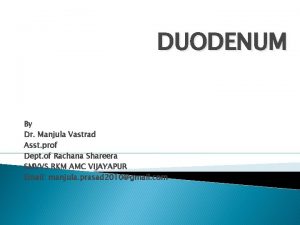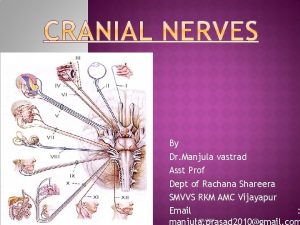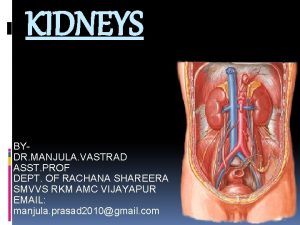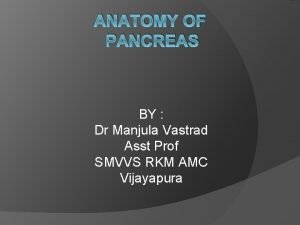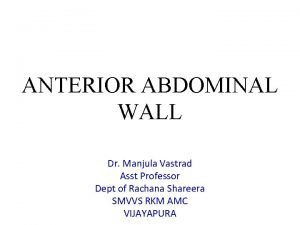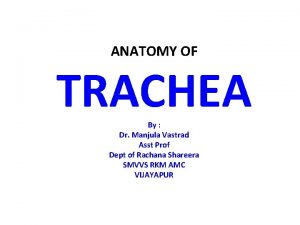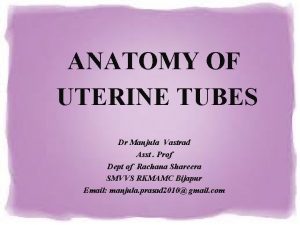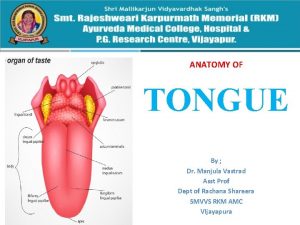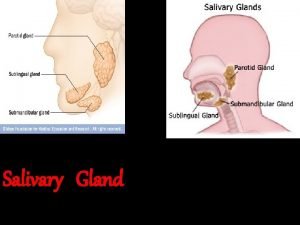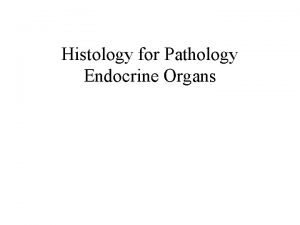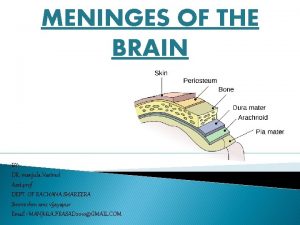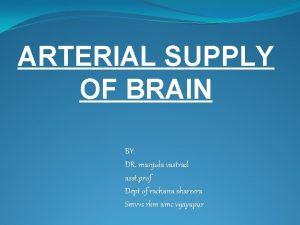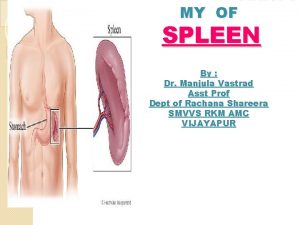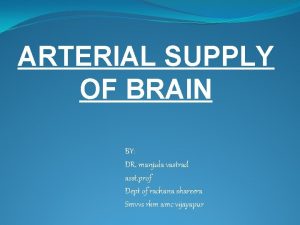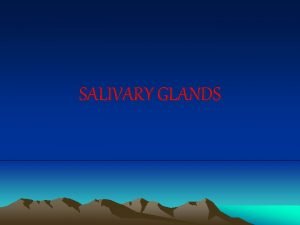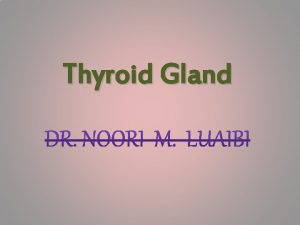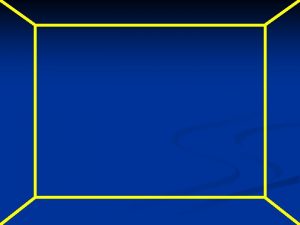PITUTARY GLAND DR MANJULA VASTRAD ASST PROF DEPT


























- Slides: 26

PITUTARY GLAND DR. MANJULA. VASTRAD ASST. PROF DEPT OF SHAREERA RACHANA SMVVS RKM AMC VIJAYAPUR Email : manjula. prasad 2010@gmail. com

DEFINITION It is an endocrine gland of a neuroglandular body which hangs from the floor of 3 rd ventricle by a stalk called infundibulum. COLOUR – Reddish grey SHAPE – Ovoid MEASUREMENTS – Transversely 12 mm Anteroposteriorly 8 mm WEIGHT – 500 mg

SITUATION – Situated in hypophyseal fossa of the sella turcica in the body of sphenoid bone covered by diaphragma sellae of duramater. COVERINGS – Covered by pia mater and arachnoid mater which is adherent to capsule of the gland. Pia mater and arachnoid mater are fused


PARTS / LOBES Consists of two parts Adenohypophysis/ Anterior lobe Further subdivided as - Pars anterior / distalis Pars intermedia Pars tuberalis Neurohypophysis / Posterior lobe Further subdivided as - Median eminence Infundibular stem Pars nervosa


RELATIONS Anteriorly– anterior intercavernous sinus Posteriorly – posterior intercavernous sinus Superiorly – optic chaisma anterior communicating artery third ventricle Inferiorly – sphenoidal air sinus Laterally – cavernous sinus with structures passing through it a) Internal carotid artery with sympathetic plexus b) Abducent, occulomotor, trochlear, opthalmic and maxillary nerves

ARTERIAL SUPPLY – Supplied by two sets of arteries Superior hypophyseal arteries supplying median eminence, pitutary stalk and the adenohyposis Inferior hypophyseal arteries supplies the infundibular process and infundibular stalk

VENOUS DRAINAGE Blood is drained by the short veins , into the cavernous sinus from adenohypophysis And via the hypothalamo-hypophyseal portal system from neurohyposis

DEVELOPMENT Anterior lobe – developed from ectoderm , from the roof of stomodium as an upgrowth dilation called Rathke’s pouch. Posterior lobe – developed as a diverticulum grows downwards from the floor of diencephalon.

HARMONES The pituitary is an important gland in the body and it is often referred to as the 'master gland', because it controls several of the other hormone glands The anterior pituitary synthesizes and secretes hormones. All releasing hormones (-RH) referred to, can also be referred to as releasing factors (-RF). Somatotrophins: Human growth hormone (HGH), also referred to as 'growth hormone' (GH), and also as somatotropin, is released under the influence of hypothalamic growth hormonereleasing hormone (GHRH).

Thyrotrophins: Thyroid-stimulating hormone (TSH), is released under the influence of hypothalamic thyrotropin-releasing hormone (TRH) and is inhibited by somatostatin. Corticotropins: Adrenocorticotropic hormone (ACTH), and Betaendorphin are released under the influence of hypothalamic corticotropin-releasing hormone (CRH).

Lactotrophins: Prolactin (PRL), also known as 'Luteotropic' hormone (LTH), whose release is inconsistently stimulated by hypothalamic TRH, oxytocin, vasopressin, vasoactive intestinal peptide, angiotensin II, and neurotensin, and inhibited by hypothalamic dopamine. Gonadotropins: Luteinizing hormone (also referred to as 'Lutropin' or 'LH'). Follicle-stimulating hormone (FSH), both released under influence of Gonadotropin-Releasing Hormone (Gn. RH)

These hormones are released from the anterior pituitary under the influence of the hypothalamus. Hypothalamic hormones are secreted to the anterior lobe by way of a special capillary system, called the hypothalamic-hypophysial portal system.

Intermediate The intermediate lobe synthesizes and secretes the following important endocrine hormone: Melanocyte–stimulating hormone (MSH). This is also produced in the anterior lobe. [6]When produced in the intermediate lobe, MSHs are sometimes called "intermedins".

Posterior The posterior pituitary stores and secretes (not synthesize) the following important endocrine hormones: Antidiuretic hormone (ADH, also known as vasopressin and arginine vasopressin AVP), the majority of which is released from the supraoptic nucleus in the hypothalamus. Oxytocin, most of which is released from the paraventricular nucleus in the hypothalamus. Oxytocin is one of the few hormones to create a positive feedback loop. For example, uterine contractions stimulate the release of oxytocin from the posterior pituitary, which, in turn, increases uterine contractions. This positive feedback loop continues throughout labour.

FUNCTIONS Hormones secreted from the pituitary gland help control the following body processes: �Growth �Blood pressure �Some aspects of pregnancy and childbirth including stimulation of uterine contractions during childbirth �Breast milk production �Sex organ functions in both males and females �Thyroid gland function �The conversion of food into energy (metabolism) �Water and osmolarity regulation in the body �Water balance via the control of reabsorption of water by the kidneys �Temperature regulation �Pain relief

All of the functions of the pituitary gland can be adversely affected by an over or under production of associated hormones.

CLINICAL SIGNIFICANCE

ACROMEGALY

DWARFISM

CUSHING’S SYNDROME

MYXOEDEMA

CRETINISM

PITUTARY TUMOR

THANK YOU
 Behavior driven development
Behavior driven development Pituitary gland and pineal gland spiritual
Pituitary gland and pineal gland spiritual Pineal gland pituitary gland
Pineal gland pituitary gland Pt dept logistik
Pt dept logistik Dept. name of organization
Dept. name of organization La revenue dept
La revenue dept Florida dept of agriculture and consumer services
Florida dept of agriculture and consumer services Dept nmr spectroscopy
Dept nmr spectroscopy Gome dept
Gome dept Gome dept
Gome dept Dept ind onegov
Dept ind onegov Dept. name of organization
Dept. name of organization Rowan county dept of social services
Rowan county dept of social services Fire dept interview questions
Fire dept interview questions Ohio dept of dd
Ohio dept of dd Oxford dept of continuing education
Oxford dept of continuing education Florida dept of agriculture and consumer services
Florida dept of agriculture and consumer services Florida department of agriculture and consumer services
Florida department of agriculture and consumer services Horizontal
Horizontal Albany county dept of social services
Albany county dept of social services Mn dept of education
Mn dept of education Nys department of homeland security
Nys department of homeland security Dept of education
Dept of education Maine department of agriculture conservation and forestry
Maine department of agriculture conservation and forestry Affiliation poster presentation
Affiliation poster presentation Nebraska dept of agriculture
Nebraska dept of agriculture Dept a
Dept a



























